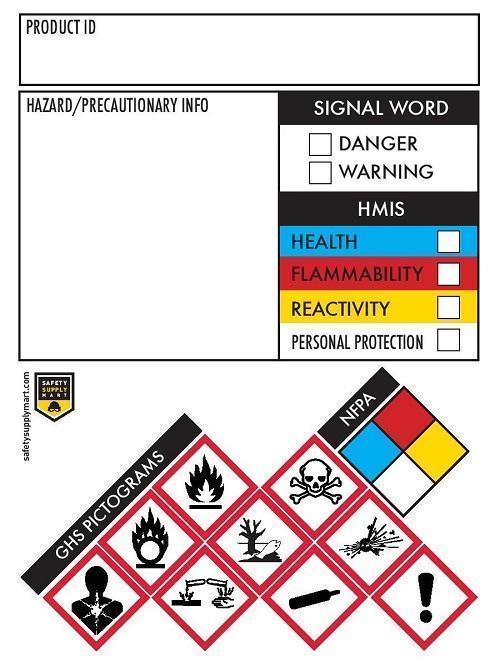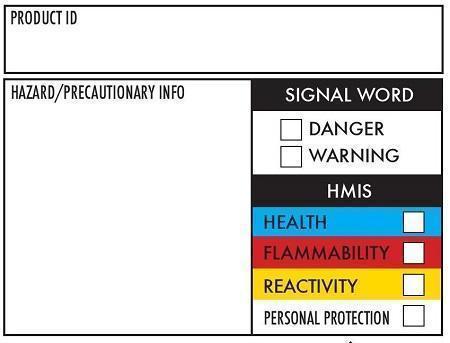When it comes to handling chemicals in the workplace, proper labeling is essential for safety and compliance. One important aspect of this is the labeling of secondary containers.
What are Secondary Containers?
A secondary container refers to any container, such as a spray bottle, pan, etc. that can hold hazardous materials that have been transferred from an original labeled container. These containers must be labeled with the same information as the original container, including the chemical name, hazard warnings, and appropriate pictograms.
How Do You Label Secondary Containers?
The first rule for proper secondary container labeling is to ensure that the label is legible and easy to read. This means using a font that is large enough to be read from a distance and using contrasting colors to make the label stand out. It’s also important to make sure that the label is not obscured by other materials or equipment. This is crucial because if the label is not legible or easy to read, it can be difficult for workers to quickly and accurately identify the chemical and its hazards, which can lead to accidents or injuries. To ensure that the label is legible and easy to read, employers should use a font that is at least 6-point in size and use contrasting colors such as black text on a white background. Additionally, they should also regularly check that the label is not obscured by other materials or equipment.
Another rule for proper secondary container labeling is to ensure that the label includes all of the required information. This includes the chemical name, hazard warnings, and appropriate pictograms as outlined by the Globally Harmonized System of Classification and Labelling of Chemicals (GHS). The chemical name should be written in full and should not be abbreviated. Additionally, it’s important to include any additional information that may be required by local or state regulations. This is important because if the label is missing any of the required information, it can be difficult for workers to quickly and accurately identify the chemical and its hazards, which can lead to accidents or injuries. To ensure that the label includes all of the required information, employers should consult the GHS and any local or state regulations, and make sure that the chemical name is written in full and not abbreviated.

An example of a secondary label sticker
It’s also important to ensure that the secondary container is properly labeled with the date of transfer and the name of the person who transferred the chemical. This information can be helpful in case of any incidents or accidents that may occur. It’s also important to make sure that the label is not removed or defaced, and that it is kept in good condition throughout the life of the container. This is important because it allows for traceability of the chemical, in case of any incidents or accidents that may occur. It also helps to identify the person who transferred the chemical and the date it was transferred, which can help to determine if the label is still valid and if the chemical has been stored for an appropriate amount of time. To ensure that the secondary container is properly labeled with the date of transfer and the name of the person who transferred the chemical, employers should have a system in place to record this information and make sure that the label is kept in good condition throughout the life of the container.
Another rule for proper secondary container labeling is to use the appropriate type of label for the container and the chemical being stored. This means using a label that is made of a durable material that can withstand the conditions in which the container will be stored, such as heat, moisture, or chemicals. It’s also important to use a label that is resistant to fading or smudging, so that the information on the label remains legible for the life of the container. This is important because if the label is not made of a durable material or is not resistant to fading or smudging, it can become illegible and difficult to read, which can lead to accidents or injuries. To ensure that the appropriate type of label is used, employers should consult the chemical supplier or manufacturer for recommendations and use a label that is resistant to fading or smudging and can withstand the conditions in which the container will be stored.
It’s also important to train employees on the proper labeling of secondary containers, as well as the appropriate handling and storage of chemicals. This includes training on the proper use of personal protective equipment (PPE), as well as the proper disposal of chemicals and containers. This is important because if employees are not properly trained on the proper labeling of secondary containers and the appropriate handling and storage of chemicals, they may not be able to identify the chemical and its hazards, which can lead to accidents or injuries. Additionally, if employees are not properly trained on the proper use of PPE and the proper disposal of chemicals and containers, they may not be able to protect themselves and the environment from chemical hazards. To ensure that employees are properly trained, employers should provide regular training on the proper labeling of secondary containers and the appropriate handling and storage of chemicals, as well as the proper use of PPE and the proper disposal of chemicals and containers.
It’s important to conduct regular inspections to ensure that secondary containers are properly labeled and that all labeling requirements are being met. This includes checking for missing or illegible labels, as well as ensuring that the information on the label is accurate and up-to-date. Any issues identified during the inspection should be corrected immediately to ensure the safety of the workers and to remain in compliance with regulations. This is important because if secondary containers are not properly labeled or if labeling requirements are not being met, it can be difficult for workers to quickly and accurately identify the chemical and its hazards, which can lead to accidents or injuries. Additionally, if inspections are not conducted regularly, issues may go undetected and unresolved, which can lead to ongoing hazards. To ensure that secondary containers are properly labeled and that all labeling requirements are being met, employers should conduct regular inspections and take prompt action to correct any issues identified.
Proper labeling of secondary containers is crucial for safety and compliance in the workplace. It’s important to follow the rules for proper labeling, use the appropriate type of container, and limit the amount of chemical transferred. By taking these steps, you can ensure that your workers are protected from chemical hazards and that your facility is in compliance with regulations. Remember, safety is everyone’s responsibility and taking the necessary steps to properly handle and store chemicals is key to maintaining a safe and healthy work environment.
References:
- https://www.osha.gov/laws-regs/standardinterpretations/2017-06-20
- https://www.osha.gov/laws-regs/regulations/standardnumber/1910/1910.1200
- 1910.1200(f)(6)(ii) “Product identifier and words, pictures, symbols, or combination thereof, which provide at least general information regarding the hazards of the chemicals, and which, in conjunction with the other information immediately available to employees under the hazard communication program, will provide employees with the specific information regarding the physical and health hazards of the hazardous chemical.”
- https://www.osha.gov/sites/default/files/publications/OSHA3636.pdf










